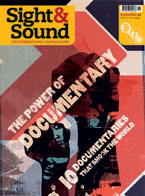
Documentary: shaking the world

Can films change history? The question prompted this special exploration of the documentary form. Mark Cousins proposes ten films that made a real difference
For years I've been arguing, in Sight & Sound and elsewhere, that to talk about the insight African cinema affords into the social and political problems of the continent is to patronise the films. I've ranted that we should be interested in the movies of the recently departed Ousmane Sembène not because they are vehicles carrying information about post-colonial society but because they are great films. After all, we don't go to see Ingmar Bergman movies because of what they say about Sweden in the 1960s. Sembène's cinema does, of course, also reveal much about its milieu - its power structures, attitudes and dress codes - just as Martin Scorsese's films do about New York City. But it's not the first thing it does.
Now, however, as curator of the Ten Documentaries That Shook the World season at BFI Southbank, I've had to do a U-turn. I've set aside questions of aesthetics to ask an empirical one: which films have had a demonstrable impact on the social, legislative or political climate in which they were made? I allowed myself to be vague about what a film is (there are made-for-TV pieces in the selection), but was determined not to commit the sin of Anglocentrism. So from China we'll show Heshang - The River Elegy (Jun Xia, 1988); from Japan Minamata: The Victims and Their World (Tsuchimoto Noriaki, 1972); from the US Bowling for Columbine (Michael Moore, 2002) and The Thin Blue Line (Errol Morris, 1988); from Britain Death of a Nation - The Timor Conspiracy (John Pilger and David Munro, 1994), BBC News Ethiopia Report (Michael Buerk and Mohammed Amin, 1984) and McLibel (Franny Armstrong, 2005); from Germany Triumph of the Will (Leni Riefenstahl, 1936); from France The Sorrow and the Pity (Marcel Ophuls, 1970);and from Iran For Freedom (Hussein Torabi, 1980).
Heshang fuelled a debate about China's relationship to western-style democracy that culminated in the Tiananmen Square protests and their brutal suppression in 1989. It set out to change the Chinese world, but ended up doing so, in part, in the wrong direction. Tsuchimoto's Minamata film charts the heartbreaking process by which a group of fishermen took the Chisso conglomerate to court for polluting the watercourse with methyl mercury. This is the original environmental documentary, and Chisso was forced to change its operation as a result. As is well known, Bowling for Columbine made Wal-Mart stop selling certain types of bullets, while The Thin Blue Line, the original miscarriage-of-justice film, won Texan drifter Randall Adams a reprieve. The outrage caused by The Timor Conspiracy was so great that it helped to bring about the liberation of East Timor in 1999. Bob Geldof saw Michael Buerk's Ethiopia Report, co-conceived Live Aid, and improved hundreds of thousands of African lives. McDonald's pulled out of schools advertising as a result of the legal challenge against the company documented in McLibel. Despite Leni Riefenstahl's lifelong claims to the contrary, as the central piece of Hitlerian marketing in the 1930s, Triumph of the Will helped to swing Germany behind its psychotic Führer. TheSorrow and the Pity, banned from French TV for more than a decade, removed the glow from France's sense of its wartime self. And For Freedom, shown every year on Iranian TV, shores up the apparent triumph of Khomeini's 1979 revolution.
The Chinese, German, Iranian and French films changed the moods of their nations, in some cases re-evaluating the past to influence the present. The three corporate films - tackling McDonald's, Chisso and Wal-Mart - are David and Goliath parables. Though documentary as formulated by John Grierson in Britain in the 1930s was a social force for the left, the Iranian and German films are right-wing works. And Pilger's and Buerk's pieces on East Timor and Ethiopia are powerful televisual expressions of post-colonial liberalism.
Yet as I write I realise what should have been obvious: that though these films were chosen because of their social impact, that impact is in part explained by aesthetics. Shoah director Claude Lanzmann said of the courtroom scene in Minamata, where the fishermen storm the directors of Chisso and jostle the camera, that it is "unparalleled in the annals of the cinema". He also talks about the "heartrending and enigmatic" beauty of the film's opening shot - a fishing boat on the sea.
Michael Moore's film is a situationist mix of John Pilgeresque moral outrage, Simpsons-style satire, mawkishness and audacious Chris Morris-type stunts. Leni Riefenstahl's Triumph of the Will is a Wagnerian attempt at a Gesamtkunstwerk that's obviously the product of a heightened, monotonal, erotic imagination. The Thin Blue Line crosses the film noir of Robert Siodmak with Crimewatch. In The Sorrow and the Pity Ophuls whips collaborationist testimony, Maurice Chevalier chansons and film clips into what he calls "a love song to France". And For Freedom, shot in colour 35mm with cranes and tracking shots, makes the Iranian revolution look Spielbergian.
These films' baroque, satirical, epic or mythic departures from the Griersonian fly-on-the-wall norms of documentary film-making surely help to explain how they got into people's heads and out into the world to bring about social change. Even the Michael Buerk report seems to have hit hard in part because of its style: years after its broadcast, BBC World Affairs editor John Simpson wrote that it was the understatement in Buerk's writing - the fact that he wasn't seen to be emoting - that allowed others to do so. The formal diversity of these films shows that documentary is less a sub-section of cinema than something like a movie megalopolis, where the genres and languages of film co-habit and interact.
